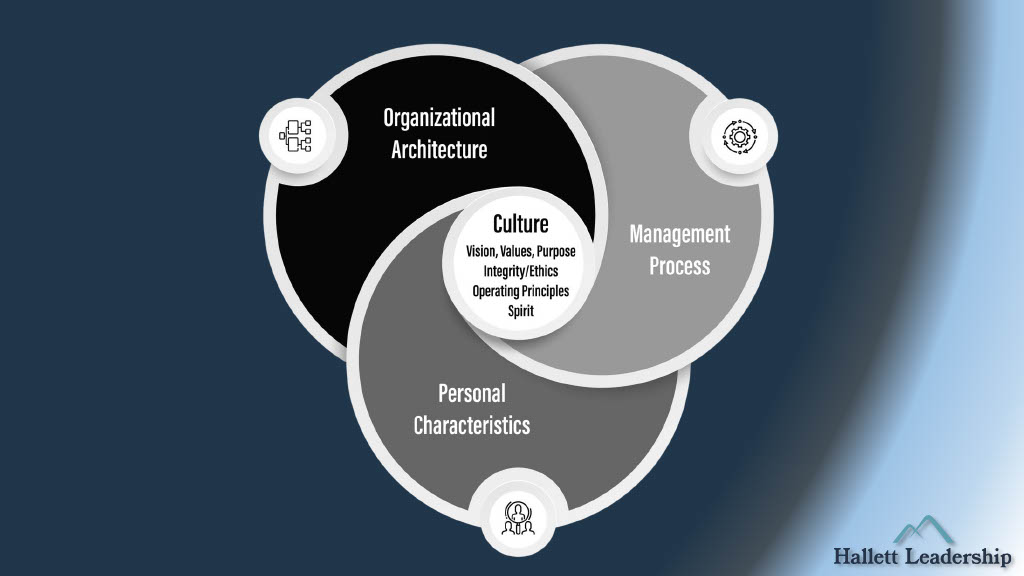
Culture is the unseen force that drives an organization forward or holds it back. It permeates every aspect of a business, from decision-making processes to employee engagement and customer loyalty. A well-crafted culture can create a self-reinforcing loop of growth and innovation, while a poorly aligned culture can lead to stagnation and frustration.
The Culture Flywheel, as illustrated below, offers a comprehensive view of the components necessary for cultivating and sustaining a meaningful culture shift. In this blog, we will explore the key elements of the Culture Flywheel, provide actionable insights for organizations looking to implement it, and discuss how Hallett Leadership can help businesses navigate this transformative process.
Decoding the Culture Flywheel Framework
At the heart of the Culture Flywheel lies culture itself, defined by vision, values, purpose, integrity, ethics, operating principles, and spirit. This central core is surrounded by three essential dimensions that operate interdependently:
- Organizational Architecture
- Resource allocation
- Strategy and structure
- Systems, policies, and procedures
- Management Processes
- Communication and planning
- Decision-making and problem-solving
- Performance management
- Personal Characteristics
- Personality traits and leadership ability
- Management style
- Technical/job skill and business acumen
The degree to which these dimensions are aligned determines the organization’s ability to influence company-specific measures of performance—such as customer loyalty, product and service quality, and individual well-being. And the degree to which the company optimizes these measures of performance determines the organization’s ability to identify and leverage external challenges and opportunities—such as technology, social and economic conditions, market forces, and competitive pressures. This interconnected system forms the “flywheel,” where positive momentum in one area feeds into the others, creating a virtuous cycle.
Why Companies Struggle With Culture Shifts
Many organizations recognize the importance of culture but struggle to achieve sustainable change. Common challenges include:
- Fragmented Efforts: Without a holistic framework, culture initiatives often lack coordination and impact.
- Resistance to Change: Employees and leaders may cling to familiar practices, fearing the unknown.
- Misaligned Incentives: If systems and policies do not support the desired culture, efforts are undermined.
- Lack of Leadership Commitment: Culture shifts require consistent modeling and reinforcement from the top.
The Culture Flywheel addresses these challenges by providing an integrated approach that aligns all aspects of the organization with its cultural vision.
Implementing the Culture Flywheel: A Strategic Approach

Truly shifting a culture requires intentionality, consistency, and alignment. Here are actionable steps for implementing the Culture Flywheel in your organization:
- Define Your Cultural Core: Start with a clear articulation of your organization’s vision, values, and purpose. These should serve as the guiding principles for all decisions and behaviors. Ensure they resonate with both leadership and employees.
- Align Organizational Architecture: Evaluate your existing systems, policies, and structures to ensure they support your cultural goals. For example:
- Update performance metrics to reflect cultural priorities.
- Redesign workflows to encourage collaboration and innovation.
- Enhance Management Processes: Strong management practices are critical for embedding culture into daily operations. Focus on:
- Transparent and consistent communication.
- Collaborative decision-making that reflects your values.
- Regular feedback and recognition to reinforce desired behaviors.
- Develop Personal Characteristics: Invest in leadership development and employee training to build the skills and mindsets needed for cultural alignment. Emphasize:
- Emotional intelligence and adaptability.
- Technical competencies aligned with strategic goals.
- Monitor and Measure Progress: Use performance indicators, employee surveys, and customer feedback to track the impact of your culture initiatives. Adjust strategies as needed to maintain momentum.
- Foster External Collaboration: Engage with stakeholders—customers, vendors, alliances—to ensure your culture extends beyond internal operations. Authentic partnerships reinforce your values and drive mutual success.
The Role of Hallett Leadership in Driving Culture Shifts

Hallett Leadership specializes in guiding organizations through transformative change. With a proven track record of helping businesses create and sustain cultural shifts, we offer expertise in:
- Leadership Development: Hallett Leadership works with executives to strengthen their ability to model and champion the desired culture. Through workshops, coaching, and tailored programs, leaders gain the tools to inspire and align their teams.
- Organizational Alignment: Our team assesses and realigns systems, structures, and processes to support cultural goals. This includes redesigning performance management systems, refining workflows, and fostering cross-departmental collaboration.
- Change Management: Sustaining a culture shift requires navigating resistance and maintaining momentum. Hallett Leadership provides strategies for overcoming barriers, engaging stakeholders, and reinforcing progress.
- Measurement and Continuous Improvement: We help organizations establish metrics and feedback loops to ensure ongoing alignment with cultural objectives. Regular evaluations enable course corrections and sustained growth.
Realizing the Benefits of a Culture-Driven Organization

Organizations that successfully implement the Culture Flywheel enjoy numerous advantages:
- Increased Employee Engagement: A strong culture fosters loyalty, motivation, and satisfaction, reducing turnover and enhancing productivity.
- Enhanced Customer Experience: Employees who embody the organization’s values deliver superior service, driving customer loyalty.
- Resilience in Uncertainty: A cohesive culture enables organizations to adapt to external changes with agility and confidence.
- Sustainable Growth: The self-reinforcing nature of the flywheel ensures that cultural momentum drives long-term success.
The Culture Flywheel provides a powerful framework for achieving and sustaining meaningful culture shifts. By focusing on the interplay between organizational architecture, management processes, and personal characteristics, businesses can create a culture that drives performance, innovation, and well-being. Hallett Leadership stands ready to partner with organizations on this journey, offering the expertise and tools needed to unlock the full potential of their culture.
Are you ready to activate your Culture Flywheel? Visit Hallett Leadership to learn more about our transformative approach and take the first step toward a thriving organizational culture.




